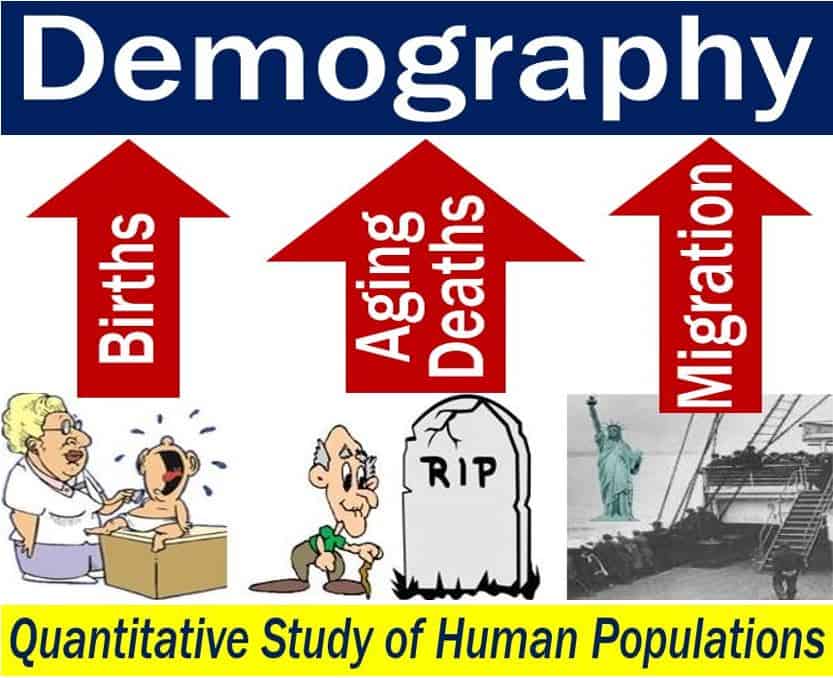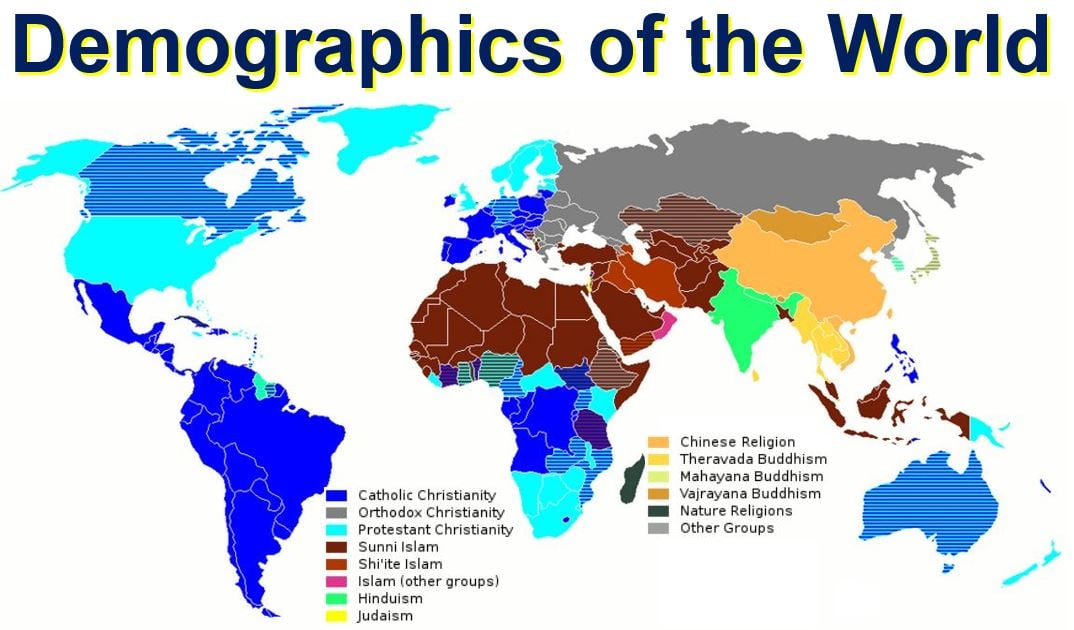Demography – definition and meaning
Demography is the statistical study of human populations. The study of statistics such as income, deaths, and births form part of the general science of demography. Demography also includes the study of disease incidences, marriages, and migration. It mainly focuses on data that illustrates the changing structure of human populations.
The term may also refer to a specific structure of a human population. For example: “The demography of the United States is changing,” means that the makeup of the country’s people is changing.
We call a population specialist a demographer. Demographers analyze dynamic living populations. In other words, populations that change over time.

Demography – study of human populations
Demography includes the study of the size, distribution, and structure of specific populations. It also covers the temporal or spatial changes in populations in response to births, deaths, aging, and migration.
Demographics are the quantifiable features of a given population. In other words, the statistical data specific to a population or groups within it.
According to BusinessDictionary.com, demography is:
“Study of both quantitative and qualitative aspects of human population. Quantitative aspects include composition, density, distribution, growth, movement, size, and structure of the population.”
History of demography
Ancient history
Demography and demographic thoughts have been around for many thousands of years. In fact, the civilizations of Ancient Rome, Ancient Greece, India, and China discussed demography extensively.
In Ancient Greece, Epicurus, Hippocrates, Thucydides, Herodotus, Polus, Protagoras, and Aristotle wrote about the subject.
Among the Roman writers, Cato, Columella, Epictetus, Marcus Aurelius, and Cicero expressed important ideas regarding demography.
Middle ages and later
Christian thinkers in the Middle Ages devoted much of their time refuting the Classical ideas on demography.
In 1662, John Graunt (1620-1674) wrote ‘Natural & Political Observations Made upon the Bills of Mortality.’ Although he was a haberdasher, he was also one of the first population specialists.
Graunt’s work contained a primitive form of the life table. He reported that one-third of all London’s children died before reaching the age of sixteen.
Astronomer Edmond Halley (1656-1742) created a life table as the basis for life insurance mathematics.
Richard Price (1723-1792) wrote the first textbook on life contingencies in 1771. In 1838, Augustus de Morgan wrote ‘On the Application of Probabilities to Life Contingencies.’

At the end of the 18th century, Thomas Robert Malthus FRS (1766-1834) concluded that populations would be subject to exponential growth if left unchecked.
Malthus warned that populations might grow faster than the growth in food production. If they did, there would subsequently be widespread famine and worsening poverty.
Demography – a separate subject
From 1980 to 1910, demography emerged from statistics as a separate field of interest. The field evolved rapidly, thanks to some mathematicians and scholars.
Statistician Achille Guillard (1799-1876) first used the term in his 1855 publication: Elements de statistique humaine, ou demographie comparee.
Three main processes
According to the Max Planck Institute, demography is the study of populations, i..e., the science of populations.
Demographers aim to understand population dynamics by investigating three principal processes: First, births; second, migration; and third, aging (including death).
This investigation often involves the use of predictive models and historical data to forecast future demographic trends and their potential impact on resources, economies, and social structures.
Each of these processes contributes to changes in populations, including how humans inhabit our planet and develop culture.
Biodemography
While most of demography’s research focuses on human beings, it also includes the field of biodemography.
Biodemography is an interdisciplinary approach to demography. It focuses on genetic, evolutionary, and epidemiological determinants. It also looks at biological considerations.
Population dynamics and features have become popular subjects among lay people. Politicians, sociologists, and economists love talking about ‘demographic change.’
Birth rates in the rich nations have fallen below the 2.1 children per woman replacement level. Life expectancy has been rising steadily and will continue to do so. The two factors contribute to ‘the aging of societies.’
Demography reports on how conditions are, have been, or will be. However, it does not offer political advice on how to tackle population problems. Furthermore, demography can inform public policy by providing insights into societal needs and challenges, such as planning for healthcare, education, and infrastructure in response to changing population trends. Demographers, however, may help by determining what the causes are.
According to the Max Planck Institute:
“Using reliable data and the statistical processing of these data, modern demographic research embraces many scientific disciplines, including mathematics, economics, and other social sciences, geography or biology.”
Demography, a derivative of ‘demos’
The term ‘demography’ is derived from the Greek root word ‘demos,’ which means ‘people.’ Many words in the English language are derived from ‘demos,’ including….
-
Democracy (noun)
A government system where the population or its representatives have the power to make decisions. As in:
“The country’s transition to democracy was marked by the first free and fair elections in decades.”
- Demagogue (noun)
A political leader who gains support by appealing to popular desires and prejudices. As in:
“The rise of the demagogue was concerning, as he capitalized on people’s fears rather than offering realistic solutions.”
-
Epidemic (noun)
A widespread occurrence of an infectious disease in a specific community at a certain time. As in:
“Health authorities declared a state of emergency due to the sudden epidemic of influenza in the region.”
-
Pandemic (noun/adjective)
A disease prevalent over an entire country or the world. As in:
“The COVID-19 outbreak was officially declared a pandemic due to its rapid spread across multiple continents.”
-
Demographic (adjective)
Related to the composition of a population, such as age, gender, and income. As in:
“Marketers often tailor their strategies to appeal to specific demographic groups based on consumer data.”
Other words that are derived from ‘demos’ include demotic, endemic, pandemic, demagogue, demography, democrat, demographic, epidemical, demophil, and demoscene.
Video – What is Demography?
This interesting video presentation, from our YouTube partner channel – Marketing Business Network, explains what ‘Demography’ is using simple and easy-to-understand language and examples.

